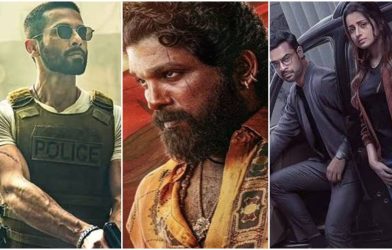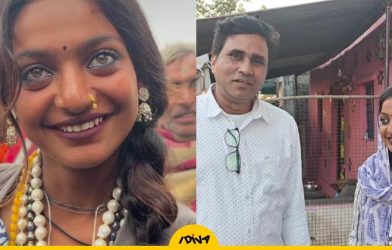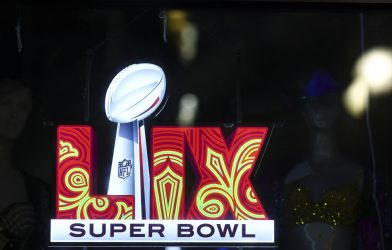Like many young Indians in the ‘90s, I grew up watching Amitabh Bachchan in Bollywood movies beat the crap out of goons who hung out at seedy beer bars. He’d be dressed in a faded leather jacket, a red bandana tied around his neck, wearing aviators at night, and proudly strait-laced. He was usually on a mission to save a damsel, helpless against drunk thugs. The bad guys, stumbling with bottles in hand, were caricatures of debauchery.
One thing was clear: If they were drinking, they were trouble.
This was the image of alcohol in India: Villains drank hooch, rich villains drank wine, and heroines didn’t drink unless they had an accidental sip and went on to have a drunken misadventure through a musical number. (Cue song “Zara Sa Jhoom Loon Mein,” where Kajol is drunk-dancing in city streets as Shah Rukh Khan tries to calm her down in the blockbuster “Dilwale Dulhania Le Jayenge,” affectionately known as DDLJ.) But almost 30 years later, that depiction has evolved. Bollywood is a major part of the Indian zeitgeist, and luckily, it’s changing the image of alcohol it once had, starting with wine.
Don’t Miss A Drop
Get the latest in beer, wine, and cocktail culture sent straight to your inbox.
Changing Perceptions
“When I was a little kid, a woman drinking wine [in Bollywood movies] was usually a vamp with a glass in one hand and a cigarette in the other, up to devious things,” says Raghni Naidu, owner and founder of Naidu Wines in California. “Now, wine is viewed as a more refined way of living.”
Naidu is one of few immigrant Indian women making wine in the U.S. She grew up in Punjab and left India in 2001, when “Dil Chahta Hai” debuted. It’s a story about the misadventures of three college grads who are best friends. She says the movie made a major impact on her generation because it was realistic and casual, though the male characters take the lead on drinking.
“Until about 2010, wines were still a very closed-door affair. It was for the tuxedo-wearing, ooh-la-la, air-kissing crowd. People who were drinking these wines were in 5-star hotels.”
According to drinks market analysis firm IWSR, wine has a promising future in India. Cultural shifts have created beneficial consumer trends resulting in accessing less tapped demographics. “In both TV and film, young and discerning characters are drinking wine, … beginning to break a connection in many consumers’ minds,” reported IWSR research analyst Jason Holway.
“Women who drink wine in movies now are educated, they have jobs and are making their own decisions in life,” says Naidu. “It’s a very normal backdrop for a modern way of living.”
This is evident in the movie “Rocky Aur Rani Kii Prem Kahaani” released this year. Alia Bhatt’s character, Rani, casually enjoys wine with her family at dinner. Ranveer Singh, who plays Rocky, is taken aback and comments that even the grandmother is pouring herself a glass. It is an obvious teaching moment, when Rani’s father responds with an “and?” The women drink in a few more scenes in the movie, but this time no one bats an eye.
Changing Economics
“Until about 2010, wines were still a very closed-door affair. It was for the tuxedo-wearing, ooh-la-la, air-kissing crowd. People who were drinking these wines were in 5-star hotels,” says Gagan Sharma, certified sommelier and owner of Indulge India, a wine education and tourism service in India. Sharma believes wine has gained popularity both on and off screen because it has become more accessible. In the past, the beverage could only be afforded by the wealthy.
“Traveling overseas, studying overseas, meant exceptional wine and dining experiences — we enjoy it and want to see it in the country.”
In the late ‘80s and ‘90s, movies by Yash Raj Films glorified travel. They were often shot in luxurious foreign locations like Switzerland, Germany, and London. This year, Switzerland even paid tribute to the late director Yash Chopra for showcasing the country in his blockbusters like “Chandni” and “Darr.” For Indian viewers, these movies were windows into snow-capped destinations and a ticket to travel vicariously.
In 2007, the median income of the Indian household nearly doubled over seven years, even after adjusting for inflation, according to the Central Statistical Organization. This meant people had extra income to spare and could travel to the dreamy locations of their favorite movies. Europe was no longer just for the rich and famous or a set for Bollywood. With trips to places like France, Italy, and the U.S., Indian consumers took in the local fare, and wine became a big part of that.
Today, India is a very promising market for beverage alcohol, with ample growth potential. Per IWSR figures for 2022, spirits volumes rose by 12 percent, beer rose by 38 percent, RTDs were up 40 percent, and wine increased by 19 percent.
“I think [some] Indians have a lot of disposable income, and are increasingly having more,” says Naidu. “Traveling overseas, studying overseas, meant exceptional wine and dining experiences — we enjoy it and want to see it in the country.”
Around the same time the median income was rising, Bollywood movies released between 2001 and 2010 had the highest depiction of wine and beer compared with past decades, according to the Indian Journal of Psychiatry. They also depicted wine in a more positive light associated with fun and relaxation — enjoyed at restaurants, bars, and clubs, with female leads shown to enjoy the drink.
I remember being mesmerized by “Zindagi Na Milegi Dobara” when it came out in 2011. And it wasn’t just because the super-dreamy Hrithik Roshan was in it. The movie is about a trio of friends who go on a bachelor trip gallivanting through Spain. I remember being drawn by how the characters effortlessly enjoyed wine, whether at an engagement party where the family clinked glasses of Champagne or at cafes in Barcelona where they ordered red for the table. They were Indians — and not goons — and the concept of casually drinking wine didn’t feel out of place.
“I’ve only seen wine getting acknowledged in India in the last 10 years. When I go back home, I go to restaurants and you see people drinking wine, there are good wine lists, there are somms on the floor.”
More recent movies like “Good Newwz,” “Love Aaj Kal” and “Love Aaj Kal 2,” “Piku,” and “Ae Dil Hai Mushkil” have varied scenes of family dinners, restaurant outings, and parties, where, besides men, women and older people drink wine, too. And popular TV programs like “MasterChef India” show housewives, among other home cooks, experimenting with international ingredients like butternut squash, macadamia nuts, and wine.
This cultural acceptance has taken decades, and there is still a long way to go — wine makes up less than 1 percent of India’s growing alcohol market, with spirits being the indisputable drink of choice. But wine is now accessible to the middle classes. And regions like Nashik in Maharashtra are touting major wineries — Sula Vineyards, York Winery, and Chandon India — where tourists pack the tasting rooms. People are curious, and it’s not just those from metropolitan cities.
The Indian Dining Experience
A world away in New York City, Michelin-starred Semma is one of the most exciting Indian restaurants in the U.S. right now. Santo Pesate, director of operations, oversees the wine lists there.
He pours wines from regions like Jura, California, and his homeland of Spain, inviting people to explore different varieties with their food. There are no wines from India on the list right now, though Indian-American producer Rajat Parr’s “Sandhi” Chardonnay from California is featured.
“Cricket and Bollywood — that’s all you have as a kid,” says Parr, who grew up in Calcutta until he was 22 years old. He recalls watching movies — the Amitabh Bachchan and Dharmendra classic “Sholay” is his favorite — but doesn’t remember wine depicted on screen.
“My parents were drinking whiskey and beer,” says Parr. “I’ve only seen wine getting acknowledged in India in the last 10 years. When I go back home, I go to restaurants and you see people drinking wine, there are good wine lists, there are somms on the floor.”
Parr is noticing a rising trend of pairing Indian food with good wine. (His favorite pairing is a skin-contact white wine with chicken tikka.) Naidu is selling a Diwali celebration 3-pack of her wines online and says there is a demand for better wine options with Indian food.
Other New York City restaurants like Indian Accent by chef Manish Mehrotra and Junoon by Rajesh Bhardwaj have extensive and award-winning wine lists. Indian Accent even carries India’s Sula Brut Tropicale Crémant de Nashik.
No Bollywood actors own a wine label in India yet, but it’s a trend I predict is soon to come. In the meantime, India is producing big-budget movies and growing a wine industry on home turf. And if Bollywood sells stories and stories sell wine, then it’s only a matter of time that wine will become as much a household commodity as the dusty DVD of DDLJ.









